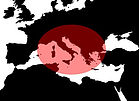Basilisk
February 5, 2017

The Basilisk as it was describe in Classical Mythology (Greek and Roman) was a small venomous serpent whose throat never touched the ground, moving as if keeping its head up, with a rooster-like crest upon its head. This crest gave it its name, for Basileus is the Greek word for king, and the basilisk was the serpent that wore the crown. Understandably, this walking-tall snake soon became the king of all serpents, gaining supernatural abilities through time and ages.
As written by R. Alexander in his article “The evolution of the Basilisk” published in 1963,

“We first meet the basilisk in Nicander’s account, in the Second century B.C, when he writes of a snake which, though only 9 inches long, is the most poisonous of all. Its hiss frightens off other reptiles, and its victims cannot safely be touched on account of the poison in them.”
We must imagine that, while the Basilisk as first describe didn’t seem quite the supernatural creature, it may have been a frightening image for the regular man of woman of the time. However, after just a couple of centuries, the Basilisk has changed, gaining abilities and attributes that made it a much more imposing beast.
Alexanders’ account continues: “Horapollo [i.e., Horus Apollo, an Egyptian priest author of Hieroglyphica] identified the basilisk with the uraeus [i.e., a sacred serpent, emblem of supreme power, worn on the headdresses of ancient Egyptian deities and sovereigns], as modern authors continue to do, and ascribe to the uraeus power of killing by breath alone.”
Later, Pliny (i.e., Gaius Plinius Secundus, Roman author) was confused by this matter and turned the Basilisk deathly breath, into a the ability of killing by sight, indicating that “seeing the basilisk’s eyes is fatal, and that the basilisk kills every man it sees.”
However, it’s in the Middle Ages when the Basilisk turns into the deathly and horrific creature we know today. Is St. Isidore’s alarming account (Etymologiae, xiii 4. 6-9) of the basilisk, often quoted in medieval bestiaries accompanied by the illustration of a cock with a serpent tail, the first to describe the basilisk as a lizard with wings and many legs, the tail of a snake, that kills with its sight, and has powerful venom-spiting fangs.
At this time, many believed that the Basilisk hatched by a cockerel from the egg of a serpent (the reverse of the Cockatrice, which is hatched from a hen’s egg incubated by a serpent’s nest). However, the account of the reproduction of basilisks that was current in the later Middles Ages (first mentioned in 1100 AD by Theophilus), described the breeding of basilisks as practiced for alchemical processes. “An egg laid by an aged cock (in this account after copulation with another aged cock) is incubated by a toad, and a basilisks hatches out.” Why a toad? Well, toads carried an evil reputation all throughout the Middle Ages, when several toad species were credited with basilisks-type properties of harmful gaze and breath, and poisonous touch. So it is possible that the involvement of a toad in basilisk procreation was to assure the deathliness of the progeny.
Text of the time give suggestion for travelers to protect themselves during encounters with a basilisk, to carry a crystal globe to reflect back the deathly stare, or to carry a weasel which can give as good as it gets by way of venomous biting and the smell of its urine will weaken the beast, or to take a cockerel with you (if there was one available near you of course), since its crowing would send the Basilisk into fits.
By Renaissance times, accounts of the basilisk described it as fully poisonous/venomous beast. Everything in the basilisk is poisonous, its bite, glance, saliva, and smell are all fatal. In addition, it can spit venom at flying birds, and its venom can rot the fruit on trees and pollute water.
References:
- Alexander, R.M., 1963. The evolution of the basilisk. Greece and Rome (Second Series), 10(02), pp.170-181.









